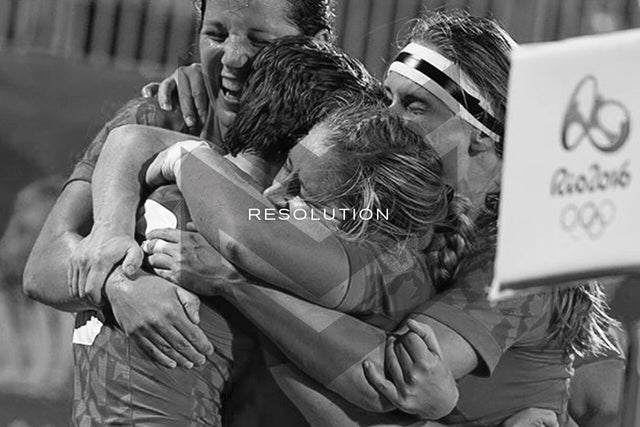Team Dynamics & Group Process: Resolution
Written By: Andrea Burk
In the last issue of The Scrum, we followed the process Canada’s Women’s Sevens team took to overcome the challenge to become Olympic bronze medalists. Resolution is the stage where the gap closes between expectations and reality. It’s the small gap that opens the door from conflict to performance. It’s the point in the story of Pandora’s Box where the strife, distress, pain and fear start to make way and hope emerges. That moment where one thinks, “Ok, I can do this.”
What does resolution look like? Feel like?
There was a clutch moment caught on camera that CBC broadcasted across the nation at the Rio Olympics. This moment captured the team bridging the resolution and performance stages as a result of the work that was done to overcome challenge, which was described by current captain Ghislaine Landry in last week’s issue.
The team was in the tunnel before their final game. Team Canada was in a huddle, rubbing their hands together, clapping in sync. (A rhythm that was likely introduced to captain Jen Kish in her early days by her first Canadian captain and loose head prop, Leslie Cripps.) What was so poignant about this moment was the look on Hannah Darling’s face; the twinkle in her eye, the small smirk as she connected with her teammates who all reflected the same expression. The sense that these sisters, this team, was about to run out and play for the love of the game. There was no longer an outcome influencing, pressuring, and closing their mindset.
Shortly after this decisive moment, Canada stormed out of the tunnel to take Great Britain 33-10 and bring home Canada’s first Olympic medal for rugby.
What can be expected from players and other group members?
Resolution appears when the individual or the group begins to challenge the problem and take ownership of its difficulty and their role in overcoming it. Accepting the challenge and accepting each other is established at this stage.
If cohesion is not formed and the group doesn’t accept the reality of the problem (or each other), they will cycle back to conflict and stay in a place of false harmony which will prolong or cut off the ability to reach a level of high-performance.
The Resolution checkpoint is passed when group members behave in a way that is inclusive and say, “this is what we have, let’s work with it and use everyone to their potential.”
What are key Resolution Phase and Group Structure indicators?
Two major developmental characteristics (or indicators) are present in each phase. These are: the group’s purpose and responsibilities, and the socio-emotional stage.
The Resolution Phase is marked by open exchange of ideas, styles and perspectives and development of group cohesion while embracing unique differences. This is where people no longer fear expressing unique views or strengths and are accepted for their unique differences. This can also be understood as, acceptance.
While all phases are important for different reasons, the Resolution Phase is particularly important for laying the significant building blocks for performance.

Leadership for resolution: What does the group (players, staff, volunteers and supporters) need? How can they be motivated?
Group members need to stay connected, be open to dialogue and self expression to process challenges and maintain a cohesive focus on the task. This process includes working with and including diverse perspectives and styles for teams to agree on a way of being and doing. The best way to get through this phase as a cohesive unit is to address behaviours that support and don’t support the group's growth towards resolution and performance in open dialogue.
Former national team coach and front rower Gary Dukelow says: “Constant and open communication should be the norm. Players must feel that they can express themselves and their unique characteristics off and on the field. Coaches are a key element in this process.”
Coaches and leaders cannot do the work for the group if high-performance is desired. They must facilitate a process allowing group members to form their own conclusions and actions based on the boundaries set by the culture. This takes time on the front end but will develop a more cohesive and self-sustaining culture in the long term.
Common challenges?
A common challenge in this phase is the desire to continue leading from an authoritarian place as is needed in the Beginning. A coach and a leader cannot do the work for the group. They must to exactly what the role inherently requires – they must coach. Leaders must facilitate a process where groups members can form their own outcomes based on the boundaries set by the culture. The best way to get through this phase as a cohesive unit is to address behaviours that both support and don’t support the group's growth toward resolution and performance.
Watch for: members who don’t take responsibility; conversations involving blame; cliques that might be forming; and any conversations that happen behind people’s backs. These are all indicators of false harmony and cycling back to the challenge/conflict phase.
How can leadership styles be adapted to meet the group's needs in pursuit of performance?
Keep a pulse on the group and encourage them to work toward resolution as a unit. Lead with energy and enthusiasm and be supportive as group members navigate their struggles.
Encourage acceptance and integration of unique strengths and perspectives. Watch for behaviour that counters this. Continue to coach, guiding the culture and holding space for group development. Resist doing the work for the group, so they can come to their own conclusions. Be the leader that says, “How are you? What is going on? This is what we are setting out to do. Where do we need support and guidance?”
Acknowledge the human process and what is going on and what is to come in each stage. This will help people to emotionally cope with what is going on and prepare for what is to come, allowing for better production and overall on-field performance.
Next Week: The Performance Phase (oh yeah!)
Team Dynamics & Stages of Group Development:
Source: Dimock, H. G., & Kass, R. (2007). How to observe your group. (4th ed.). Concord, ON: Captus Press.


